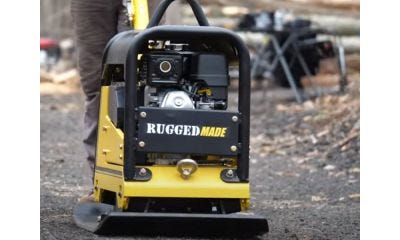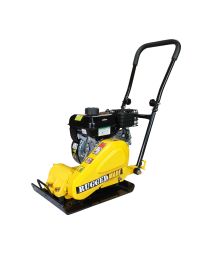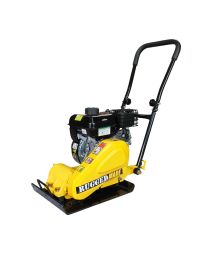

If you want a job to look professionally done, you have to use the right tools. From laying a paver walkway or patio to preparing to build a house, vibrating plate compactors can make the difference between a failed project and work to be proud of. So, what is a plate compactor, and how do you choose the right one? Read on to find out.
Plate Compactor Uses
A vibrating plate compactor is a piece of construction equipment that uses centrifugal force to compact granular material like sand, gravel, or asphalt milling, making it denser and creating a more stable base for whatever you're building.
Here are some examples of projects you can use plate compactors for, in order from smallest to largest:
- Landscaping jobs like retaining walls and garden paths
- Cobblestone patios
- Driveways and sidewalks
- Foundations for homes and buildings
- Road repairs
The bigger the job, the more force you'll need, so let's look at the specifications you should understand before choosing your machine.


What Size Plate Compactor Do I Need?
The size you need will depend on the size of the job. Here are a few definitions related to plate compactor sizes:
- Plate size - If you're working on a simple garden path, a narrow 20" x 14" base plate should do the job. For larger construction projects like building foundations or road repairs, a 35" x 24" base plate will cover larger areas faster. You can find a range of sizes to fit any job.
- Centrifugal force - You might recall thinking in science class that you'd ever need to know that phrase, but it's the key to knowing how deep your compaction will go. Smaller plate compactors provide 2,400 pounds of force per square foot, with compaction going as deep as 8". RuggedMade's largest plate compactor model can deliver 9,000 pounds per square foot and compact to a depth of 34".
- Vibrating frequency - The frequency is the number of times the plate hits the surface in a minute. The higher the frequency, the better the compaction of materials like asphalt.
If you're wondering how much a plate compactor weighs, our smallest compactors start at 140 pounds. Ask for help to move them, and remember to lift them with your legs. Wheel kits are available for our smaller compactors like the FC140 plate compactor. Our largest plate compactor tips the scale at 750 pounds. Larger compactors like the RCH260, RCH280, and RCH780 come standard with wheel kits to help move them around on the ground and hoist points for loading and unloading at the job site.
How to Use a Plate Compactor
While the instructions for running a plate compactor will vary by brand, they all have some basic operating guidelines in common.
- Wear protective gear – gloves, goggles, steel-toe boots, and long pants are recommended.
- When starting the engine, always set the throttle to the idle position. The compactor will vibrate when the engine starts, so do not start at full throttle.
- Return the throttle to the idle position before turning off the engine.
- The site should be graded and leveled for the best results before using the plate compactor.
- Use a rubber pad attachment when compacting pavers so they don't crack.
- Lightly moisten the surface of the material you are compacting. This will allow the particles to slide together during compaction. Water tank attachments like the one available on our FC185 plate compactors allow you to spray down the surface as you work.
- The motion of the vibrating plate will propel the plate compactor in a forward motion if it's a forward-only compactor. Although it's technically forward-only, a unique feature of the FC205 plate compactor is its handle, which can easily be flipped between opposing positions while switching travel directions.
- Some models like the RCH260, RCH280, and RCH780 are bi-directional or reversible plate compactors. The forward and reverse motion is controlled hydraulically with the handle. Pushing forward on the handle will control the forward motion, and pulling back on the handle will engage the reverse direction.
Should I Rent or Buy a Plate Compactor?
The decision of whether to buy or not to buy depends on how often you plan to use the equipment. For example, if you're creating a quick backyard fire pit and you'll never use it again, then renting makes sense!
But if you have big plans for hardscaping projects on your property, run a landscaping or construction company, or work for a municipality fixing roadways and sidewalks, owning your own plate compactor will probably save you money in the long run. Let's do some basic number crunching:
A big box home improvement store rents a 20" vibratory plate compactor for $83 per day.
You can buy a new 20" vibratory plate compactor from RuggedMade starting at $922.
$922 divided by $83 = 11.11
So, if you plan to use it for more than eleven days, it will pay for itself. Plus, relying on the rental company for availability may limit your ability to get the job done in a timely manner. Plate compactors are mechanically simple machines and easy to work on, but rental companies are notorious for not maintaining their equipment, so you never know what you'll get when you choose to rent.
When you purchase versus renting you know you are maintaining your equipment properly, including cleaning it, changing the oil, etc., and you know it's stored out of the elements when not in use (not sitting in the back of some guy's truck all week).
If purchasing is right for you, check out RuggedMade's line of vibrating plate compactors.








